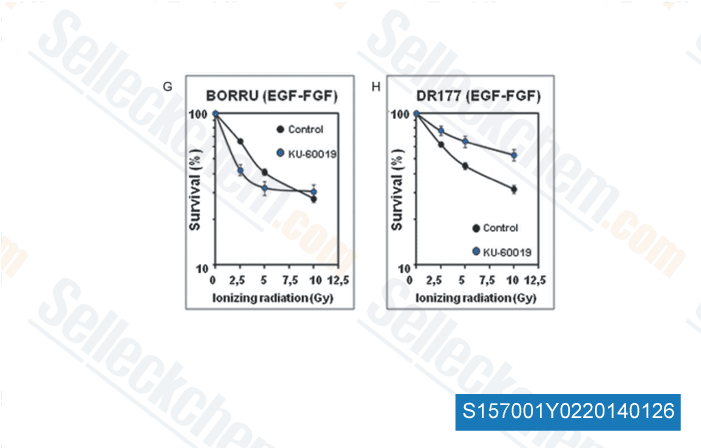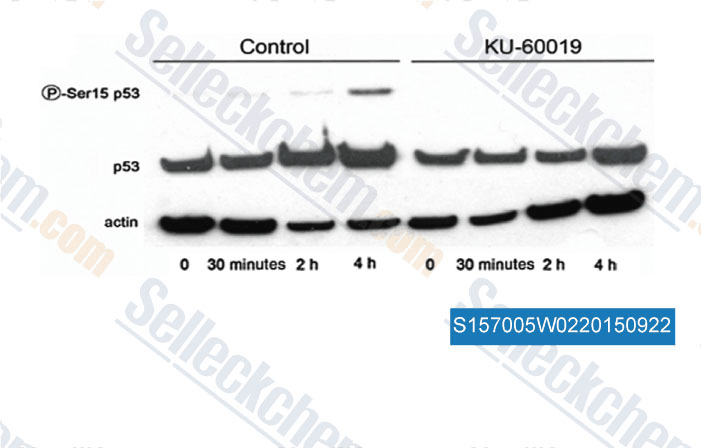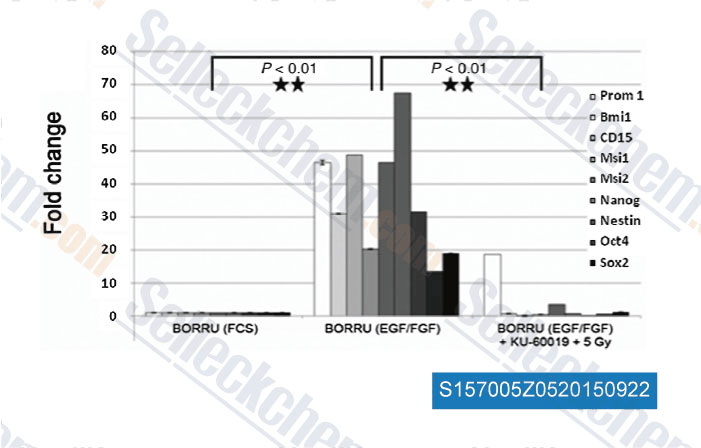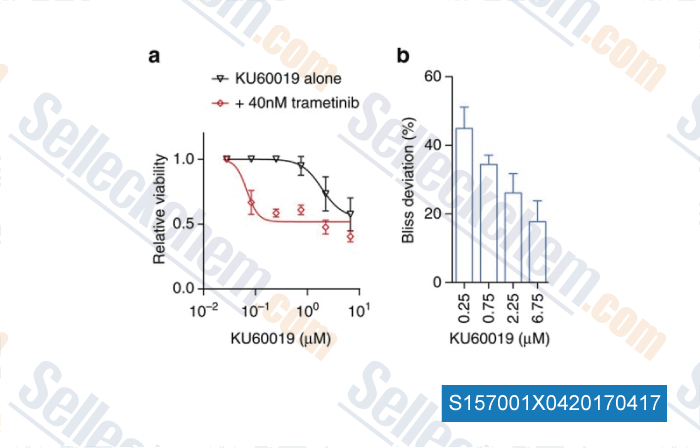|
Toll Free: (877) 796-6397 -- USA and Canada only -- |
Fax: +1-832-582-8590 Orders: +1-832-582-8158 |
Tech Support: +1-832-582-8158 Ext:3 Please provide your Order Number in the email. |
Technical Data
| Formula | C30H33N3O5S |
|||
| Molecular Weight | 547.67 | CAS No. | 925701-49-1 | |
| Solubility (25°C)* | In vitro | DMSO | 100 mg/mL (182.59 mM) | |
| Water | Insoluble | |||
| Ethanol | Insoluble | |||
|
* <1 mg/ml means slightly soluble or insoluble. * Please note that Selleck tests the solubility of all compounds in-house, and the actual solubility may differ slightly from published values. This is normal and is due to slight batch-to-batch variations. * Room temperature shipping (Stability testing shows this product can be shipped without any cooling measures.) |
||||
Preparing Stock Solutions
Biological Activity
| Description | KU-60019 is an improved analogue of KU-55933, with IC50 of 6.3 nM for ATM in cell-free assays, 270- and 1600-fold more selective for ATM than DNA-PK and ATR,and is a highly effective radiosensitizer. | ||
|---|---|---|---|
| Targets |
|
||
| In vitro | Compared to KU-55933, KU-60019 is an improved inhibitor of the ATM kinase, while displaying similar target selectivity. KU-60019 has little activity against DNA-PKcs and ATR with IC50 values of 1.7 μM and >10 μM, respectively, as well as 229 other protein kinases such as PI3K, mTOR and mTOR/FKBP12. KU-60019 displays 3- to 10-fold more potency than KU-55933 at blocking radiation-induced phosphorylation of key ATM protein targets such as p53, γ-H2AX, and CHK2, in human glioma U87 and U1242 cells, as 1 μM of KU-60019 significantly induces >70% decrease of p53 (S15) phosphorylation to which extent ~10 μM of KU-55933 is required to achieve. KU-60019 effectively radiosensitizes human glioma cells with dose-enhancement ratio of 1.7 and 4.4 at 1 μM and 10 μM, respectively, and also radiosensitizes the normal fibroblasts but not the A-T fibroblasts. KU-60019 treatment (3 μM) blocks basal and insulin-induced AKT S473 phosphorylation by 70% and ~50%, respectively, and completely reduces radiation-induced AKT phosphorylation below the level of control. The effect of KU-60019 on AKT S473 phosphorylation can be seen in glioma cell lines and normal fibroblasts but not in A-T (h-TERT) cells, and can be significantly blocked by phosphatase inhibitor okadaic acid, suggesting a critical role of ATM kinase in regulating AKT phosphorylation via unknown phosphatase. Consistent with the inhibition of prosurvival AKT signaling, KU-60019 at 3 μM significantly inhibits migration and invasion of human glioma U87 cells by >70% and ~60%, respectively, as well as U1242 cells by >50% and ~60% respectively. [1] |
||
| In vivo | In orthotopic glioma U1242/luc-GFP xenograft models, the combination of KU-60019 and radiation significantly increases survival of mice than KU-60019 alone, radiation alone, or no treatment. In addition, p53-mutant gliomas is much more sensitive to KU-60019 radiosensitization than wild-type glioma. [2] |
||
| Features | Improved analog of KU-55933, and is more effective at blocking ATM-mediated DDR events. |
Protocol (from reference)
| Cell Assay: |
|
|---|---|
| Animal Study: |
|
References
|
Customer Product Validation

-
Data from [Brain Pathol, 2012, 22(5), 677-88]

-
Data from [Data independently produced by , , Brain Pathol, 2012, 22(5): 677-88 ]

-
Data from [Data independently produced by , , Brain Pathol, 2012, 22(5): 677-88 ]

-
Data from [Data independently produced by , , Nat Commun, 2016, 7:13701]
Selleck's KU-60019 has been cited by 151 publications
| ATR Inhibition Synergizes With Alkylating PI Polyamide Targeting MYCN by Suppressing DNA Repair in MYCN-Amplified Neuroblastoma [ Cancer Sci, 2025, 10.1111/cas.70043] | PubMed: 40052411 |
| Heterogeneity-driven phenotypic plasticity and treatment response in branched-organoid models of pancreatic ductal adenocarcinoma [ Nat Biomed Eng, 2024, 10.1038/s41551-024-01273-9] | PubMed: 39658630 |
| Inhibition of topoisomerase 2 catalytic activity impacts the integrity of heterochromatin and repetitive DNA and leads to interlinks between clustered repeats [ Nat Commun, 2024, 15(1):5727] | PubMed: 38977669 |
| ATM inhibition enhance immunotherapy by activating STING signaling and augmenting MHC Class I [ Cell Death Dis, 2024, 15(7):519] | PubMed: 39033176 |
| Loss of POLE3-POLE4 unleashes replicative gap accumulation upon treatment with PARP inhibitors [ Cell Rep, 2024, 43(5):114205] | PubMed: 38753485 |
| Topological stress triggers persistent DNA lesions in ribosomal DNA with ensuing formation of PML-nucleolar compartment [ Elife, 2024, 12RP91304] | PubMed: 39388244 |
| Simple aneuploidy evades p53 surveillance and promotes niche factor-independent growth in human intestinal organoids [ Mol Biol Cell, 2024, 35(8):br15] | PubMed: 38985518 |
| Replicative senescence is ATM driven, reversible, and accelerated by hyperactivation of ATM at normoxia [ bioRxiv, 2024, 2024.06.24.600514] | PubMed: 38979390 |
| Reciprocal links between methionine metabolism, DNA repair and therapy resistance in glioblastoma [ bioRxiv, 2024, 2024.11.20.624542] | PubMed: 39651281 |
| RHOJ controls EMT-associated resistance to chemotherapy [ Nature, 2023, 616(7955):168-175] | PubMed: 36949199 |
RETURN POLICY
Selleck Chemical’s Unconditional Return Policy ensures a smooth online shopping experience for our customers. If you are in any way unsatisfied with your purchase, you may return any item(s) within 7 days of receiving it. In the event of product quality issues, either protocol related or product related problems, you may return any item(s) within 365 days from the original purchase date. Please follow the instructions below when returning products.
SHIPPING AND STORAGE
Selleck products are transported at room temperature. If you receive the product at room temperature, please rest assured, the Selleck Quality Inspection Department has conducted experiments to verify that the normal temperature placement of one month will not affect the biological activity of powder products. After collecting, please store the product according to the requirements described in the datasheet. Most Selleck products are stable under the recommended conditions.
NOT FOR HUMAN, VETERINARY DIAGNOSTIC OR THERAPEUTIC USE.
